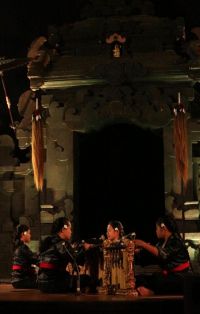- Type of Performance
- Music
- Photo reference
- Dokumentasi oleh Mang Sraya
- Genre
- Musik Kontemporer
- Composer
- Ni Nyoman Srayamurtikanti Mang Sraya
- Musicians, group or orchestra
- Sanggar S'mara Murti
- Place of origin
- Banjar Celuk, Kecamatan Sukawati, Gianyar, Bali
- Instruments
- Gender Wayang
- Related Books
- Related Holidays
Videos
Description
In English
This work uses the ensemble Gender Wayang. The musical work system carried out in this work is based on several impacts that cause and are caused by speech delay associated with the textual work, that are:
1. Speech articulation disorders are interpreted by the use of the gender wayang’s mallet handle in this composition work. In general, the gender wayang repertoire does not use the mallet’s handle to hit the blades.
2. Receptive (input) and expressive (output) language disorders are interpreted by the relay system or rotating. In general the gender wayang’s musical system is performed simultaneously by all instruments. However, this work uses a rotating system.
3. Have a strong imagination interpreted by using many different melodies on each instrument. This is different from the gender wayang repertoire system, which in general has one melody with polos (on beat melody) and sangsih (off beat melody) ornaments.
In this work, the composer divides the composition into four parts. Each section represents the textual ideas and concepts that are made, namely:
1. In the first part, the composer uses a gender wayang’s mallet handle hips. The initial part starts with Kantilan 1 by hitting several short melodies that are repeated several times. Then the Kantilan 1 player hits a note on the Pemade 1 instrument which is meant to give action to the next player. Player 1 responds by playing several short melodies that are different in response to the action given by the previous player.
2. In the second part using a medium tempo. There is a melody division between kantilan and pemade. Kantilan plays 2 notes alternating at a fast pace and different sizes. In between these melodies, pemade provides an accent as a marker or explanation for the melody of the performance. Then proceed with a melody totaling 8 beats with a sequential progression of notes back and forth, each of which has a different tone arrangement. The melodies are played relay or alternately.
3. In the third part, the tempo is slower and gradually accelerates. In this section the composers make a melody that is the same as each other by emphasizing the dynamics of each instrument. Then proceed with the imitation of one of the gender wayang repertoires, namely: angkat-angkatan. Gending angkat-angkatan on gender wayang is one type of gender wayang repertoire which is interpreted or often used as a wayang companion when walking towards the battlefield. In this type of gending has 2 different melodies which are played by the right hand and the left hand. The melody on the left hand usually consists of 4 beats that are repeated from beginning to end while the melody on the right hand is more agile and varies in pitch progression. In this case, each instrument has a different melody but is tied to one another or is called polyphony.
4. In the fourth part, using a polymmetric technique where each instrument has a different size bar. Kantilan 1 uses the beat 5/4, pemade 1 uses the beat 10/4, kantilan 2 uses the beat ¾ and pemade 2 uses the beat 6/4. In 1 lap, all the instruments will meet on beat 30. Each instrument has a different song sentence but on beat 20, the instruments will be brought together in almost the same rhythm. Then as a closing there is a kebyar with a different tone arrangement between kantilan and pemade.
Speech Delay's work has been staged at the Ancient Creative Music festival in 2020. Mang Sraya's other musical works can be heard and watched on her YouTube channel: Sraya Murtikanti.In Balinese
Speech delay, silih sinunggil komposisi musik sakeng komponis istri Bali sane mapesengan Ni Nyoman Sraya Murtikanti. Mang Sraya, nika pungkusan ipun lulusan sakeng Institut Seni Indonesia Denpasar sane mangkin ngelanturan masekolah Master ring Institut Seni Indonesia Surakarta sampun akeh ngripta tur ngametuan musik kreatif sane kantun madasar antuk pakem-pakem tradisi. Speech delay, utawi lat mebaosan pinaka istilah umum nuju kasuksman sakeng anake sane lat uning ngeraos miwah mebabaosan sane nenten manut sareng yusan anake alit. Silih sinunggil semeton istri ne Mang Sraya naenin keni Speech Delay, sakewanten naenin keni pinyungkan lat ngeraos tur mabaosan, ipun medue kewagedan rikalaning ngelingan miwah madue rasa imajinasi sane becik. Kawentenan punika ngicenin Mang Sraya ide miwah inspirasi raris kabakta ring musik kreatif punika.
Tabuh puniki nganggen piranti Gender Wayang. Polah palih tetabuhane madasar antuk pikobet-pikobet sane kametuang olih speech delay punika, raris kaolah miwah ketafsiran sareng wangun tekstual garapan minakadi: 1. Pikobet nganinin indik artikulasi babaosan kacihnayang olih katik panggul gender sane kaanggen nepak daun gamelan gender wayange punika. Yadiastun ring serahinane katik panggule punika nenten naenin kaanggen nepak bilah-bilah gamelan.
2. Pikobet basa reseptif input utawi mirengin babaosan, miwah ekspresif output utawi mababaosan kacihnayang antuk sistem estafet utawi magiliran. Ring tabuh gender wayang sane umum, tata cara gegebugannyane kamargiang sinarengan, sakewanten ring garapan puniki tata cara gegebungannyane kamargiang slegenti utawi magiliran.
3. Madue kewagedan ring daya imajinasi becik, kakantenan antuk melodi sane setata metiosan ring sekancan piranti gamelan gender wayang. Indike puniki mabinayan sareng gending gender wayang sane sampun ketah kamargiang nganggen melodi asiki inggih puniki wantah melodi polos lan sangsih.
Ring tabuh puniki, sang pangripta ngepah tetabuhane antuk petang pepalihan. Ring sekancan pepalihan nyihnayang ide miwah bantang utawi unteng sakeng garapan tabuhe punika.
1. Ring pah-pahan kapertama, nganggen katik panggul gender sane kakawitin sakeng kantilan antuk nyuarayang melodi sane bawak, tur kaulang-ulang. Raris juru tabuh kantilan nepak asiki nada ring piranti pemade sane matatujon mangdane juru tabuh pemade prasida ngelanturan tetabuhane antuk ngamargiang makudang-kudang melodi sane sane metiosan sareng melodi bawak kantilan I.
2. Ring pah-pahan kaping kalih nganggen tempo utawi mat sane sedeng. Wenten malih pah-pahan melodi sakeng pemade sareng kantilan. Kantilan nabuhang nada nyilih asih nganggen tempo becat miwah sikut sane mabinayan. Ring selagan melodi punika, pemade ngicenin aksen pinaka ceciren nguncab majeng ring melodi kantilan. Raris kelanturang antuk melodi sane akehnyane kutus kajar, jajaran suarane punika nyilih asih tur selegenti katabuhang.
3. Ring pah-pahan sane kaping tiga, nganggen mat sane banban raris sekakidik mecatang. Ring wawidangan puniki, sang pangripta nganggen melodi sane pateh sakewanten tetueknyane ring dinamika risajeroning sekancan piranti gender wayang punika. Raris kelanturang antuk nulad silih sinunggul tabuh gender wayang sane mawasta Angkat-angkatan. Gending angkat-angkatan pinaka silih sinunggil tabuh gender wayang sane kaanggen rikalaning ngambelin wayang tatkala nuju genah meperang. Ring gending puniki wenten kalih soroh melodi matiosan sane katabuhang olih tangan ring tengen miwah tangan ring kiwa. Pola melodi Ring tangan kiwa nganggen nada kajar sane terus kaulang-ulang ngantos puput. Ring tangan tengen sayan lincah tur variatif ring sajeroning nadanyane. Indike puniki sekancan pirantine punika madue melodi sane mabinayan sakewanten sujatine sami saling mapaiketan dados asiki. Indike punika sane kawastanin polifoni.
4. Ring pah-pahan kaping pat. Nganggen teknik polimetrik wastannyane. Ring sekancan piranti gender wayang punika nganggen makudang-kudang sikut birama sane matiosan. Kantilan nganggen mat 4, pemade nganggen kajar 10 4, kantilan nganggen pemade nganggen 4. Ring ailehan, samian piranti gender pacang macepuk ring ketukan kaping 30. Sekancan piranti gender medue lengkara nada sane matiosan, sakewanten pacang katemu ring ketukan 20. Piranti gender punika pacang katemuang antuk angsel-angsel sane mirip. Raris pinaka panguntat tetabuhan kadagingin kebyar antuk jajaran nada sane matiosan sakeng kantilan sareng pemade.
Karya tabuh kreasi Speech Delay puniki sampun kapentasang ring festival Musik Kreatif Kuno Kini duk warsa 2020 kalih tali kalih dasa Tabuh-tabuh tiosan sane karipta olih Mang Sraya prasida kapiarsayang ring kanal Youtube Sraya Murtikanti.
Speech delay, silih sinunggil komposisi musik sakeng komponis istri Bali sane mapesengan Ni Nyoman Sraya Murtikanti. Mang Sraya, (nika pungkusan ipun) lulusan sakeng Institut Seni Indonesia Denpasar sane mangkin ngelanturan masekolah Master ring Institut Seni Indonesia Surakarta sampun akeh ngripta tur ngametuan musik kreatif sane kantun madasar antuk pakem-pakem tradisi. Speech delay, utawi lat mebaosan pinaka istilah umum nuju kasuksman sakeng anake sane lat uning ngeraos miwah mebabaosan sane nenten manut sareng yusan anake alit. Silih sinunggil semeton istri ne Mang Sraya naenin keni Speech Delay, sakewanten naenin keni pinyungkan lat ngeraos tur mabaosan, ipun medue kewagedan rikalaning ngelingan miwah madue rasa imajinasi sane becik. Kawentenan punika ngicenin Mang Sraya ide miwah inspirasi raris kabakta ring musik kreatif punika.Tabuh puniki nganggen piranti Gender Wayang. Polah palih tetabuhane madasar antuk pikobet-pikobet sane kametuang olih speech delay punika, raris kaolah miwah ketafsiran sareng wangun tekstual garapan minakadi: 1. Pikobet nganinin indik artikulasi babaosan kacihnayang olih katik panggul gender sane kaanggen nepak daun gamelan gender wayange punika. Yadiastun ring serahinane katik panggule punika nenten naenin kaanggen nepak bilah-bilah gamelan.
2. Pikobet basa reseptif (input) utawi mirengin babaosan, miwah ekspresif (output) utawi mababaosan kacihnayang antuk sistem estafet utawi magiliran. Ring tabuh gender wayang sane umum, tata cara gegebugannyane kamargiang sinarengan, sakewanten ring garapan puniki tata cara gegebungannyane kamargiang slegenti utawi magiliran.
3. Madue kewagedan ring daya imajinasi becik, kakantenan antuk melodi sane setata metiosan ring sekancan piranti gamelan gender wayang. Indike puniki mabinayan sareng gending gender wayang sane sampun ketah kamargiang nganggen melodi asiki inggih puniki wantah melodi polos lan sangsih.
Ring tabuh puniki, sang pangripta ngepah tetabuhane antuk petang (4) pepalihan. Ring sekancan pepalihan nyihnayang ide miwah bantang utawi unteng sakeng garapan tabuhe punika.
1. Ring pah-pahan kapertama, nganggen katik panggul gender sane kakawitin sakeng kantilan I antuk nyuarayang melodi sane bawak, tur kaulang-ulang. Raris juru tabuh kantilan I nepak asiki nada ring piranti pemade I sane matatujon mangdane juru tabuh pemade I prasida ngelanturan tetabuhane antuk ngamargiang makudang-kudang melodi sane sane metiosan sareng melodi bawak kantilan I.
2. Ring pah-pahan kaping kalih nganggen tempo utawi mat sane sedeng. Wenten malih pah-pahan melodi sakeng pemade sareng kantilan. Kantilan nabuhang 2 nada nyilih asih nganggen tempo becat miwah sikut sane mabinayan. Ring selagan melodi punika, pemade ngicenin aksen pinaka ceciren nguncab majeng ring melodi kantilan. Raris kelanturang antuk melodi sane akehnyane kutus kajar, jajaran suarane punika nyilih asih tur selegenti katabuhang.
3. Ring pah-pahan sane kaping tiga, nganggen mat sane banban raris sekakidik mecatang. Ring wawidangan puniki, sang pangripta nganggen 1 melodi sane pateh sakewanten tetueknyane ring dinamika risajeroning sekancan piranti gender wayang punika. Raris kelanturang antuk nulad silih sinunggul tabuh gender wayang sane mawasta Angkat-angkatan. Gending angkat-angkatan pinaka silih sinunggil tabuh gender wayang sane kaanggen rikalaning ngambelin wayang tatkala nuju genah meperang. Ring gending puniki wenten kalih soroh melodi matiosan sane katabuhang olih tangan ring tengen miwah tangan ring kiwa. Pola melodi Ring tangan kiwa nganggen nada 4 kajar sane terus kaulang-ulang ngantos puput. Ring tangan tengen sayan lincah tur variatif ring sajeroning nadanyane. Indike puniki sekancan pirantine punika madue melodi sane mabinayan sakewanten sujatine sami saling mapaiketan dados asiki. Indike punika sane kawastanin polifoni.
4. Ring pah-pahan kaping pat. Nganggen teknik polimetrik wastannyane. Ring sekancan piranti gender wayang punika nganggen makudang-kudang sikut birama sane matiosan. Kantilan I nganggen mat 5/4, pemade I nganggen kajar 10/4, kantilan 2 nganggen ¾, pemade 2 nganggen 6/4. Ring ailehan, samian piranti gender pacang macepuk ring ketukan kaping 30. Sekancan piranti gender medue lengkara nada sane matiosan, sakewanten pacang katemu ring ketukan 20. Piranti gender punika pacang katemuang antuk angsel-angsel sane mirip. Raris pinaka panguntat tetabuhan kadagingin kebyar antuk jajaran nada sane matiosan sakeng kantilan sareng pemade.
Karya tabuh kreasi Speech Delay puniki sampun kapentasang ring festival Musik Kreatif Kuno Kini duk warsa 2020 (kalih tali kalih dasa). Tabuh-tabuh tiosan sane karipta olih Mang Sraya prasida kapiarsayang ring kanal Youtube Sraya Murtikanti.In Indonesian
Speech Delay atau keterlambatan berbicara merupakan istilah umum yang merujuk pada proses keterlambatan berbicara dan berbahasa yang tidak sesuai dengan perkembangan usia anak. Salah satu saudara perempuan Mang Sraya mengalami speech delay, tetapi meskipun mengalami keterlambatan berbicara dan berbahasa, beliau memiliki daya ingat yang sangat tajam dan imajinasi yang kuat. Pengalaman personal ini kemudian memberi inspirasi pada Mang Sraya dan menginterpretasikannya ke dalam karya komposisi musik kreatif.
Karya ini menggunakan ensambel Gender Wayang. Sistem kerja musikal yang dilakukan dalam garapan ini berdasar pada beberapa dampak yang menyebabkan dan disebabkan oleh speech delay yang memungkinkan untuk dikaitkan dengan tekstual garapan, yaitu :
1. Gangguan artikulasi bicara diinterpretasikan dengan penggunaan tangkai panggul gender wayang dalam karya komposisi ini. Dalam repertoar gender wayang secara umum tidak menggunakan tangkai panggul untuk memukul bilah-bilah.
2. Gangguan bahasa reseptif (input) dan ekspresif (output) diinterpretasikan dengan sistem estafet atau bergiliran. Dalam repertoar gender wayang secara umum, sistem permainannya dilakukan secara bersamaan oleh semua instrument. Namun, pada karya ini menggunakan sistem bergiliran.
3. Memiliki daya imajinasi kuat diinterpretasikan dengan menggunakan banyak melodi berbeda pada setiap instrument. Hal ini berbeda dari sistem repertoar gender wayang yang secara umum memiliki satu melodi dengan ornamen polos dan sangsih.
Dalam karya ini, komposer membagi komposisi ke dalam empat bagian. Setiap bagian mewakili ide dan konsep tekstual garapan, yaitu :
1. Pada bagian pertama, penata menggunakan bagian bawah / tangkai panggul gender wayang. Pada bagian awal dimulai oleh kantilan 1 dengan memukul beberapa melodi pendek yang diulang beberapa kali. Kemudian pemain kantilan 1 memukul satu nada pada instrument pemade 1 yang dimaksudkan untuk memberikan aksi pada pemain selanjutnya. Pemain pemade 1 merespon dengan memainkan beberapa melodi pendek yang berbeda respon dari aksi yang diberikan oleh pemain sebelumnya.
2. Pada bagian kedua menggunakan tempo sedang. Terdapat pembagian melodi antara kantilan dan pemade. Kantilan memainkan 2 nada silih berganti dengan cepat dan ukuran yang berbeda. Di sela-sela melodi tersebut, pemade memberikan aksen sebagai penanda atau penjelas untuk melodi kantilan. Kemudian dilanjutkan dengan melodi yang berjumlah 8 ketuk dengan progresi nada berurutan dan bolak balik yang pada setiap instrumennya memiliki susunan nada berbeda. Melodi-melodi tersebut dimainkan secara estafet atau bergantian.
3. Pada bagian ketiga, tempo yang digunakan adalah pelan dan berangsur-angsur dipercepat. Pada bagian ini penata membuat satu melodi yang sama antara satu sama lainnya dengan lebih menekankan dinamika pada setiap instrumen. Kemudian dilanjutkan dengan imitasi dari salah satu repertoar gender wayang yaitu: angkat-angkatan. Gending angkat-angkatan pada gender wayang adalah salah satu jenis repertoar gender wayang yang diartikan atau sering digunakan sebagai pengiring wayang ketika berjalan menuju medan perang. Dalam jenis gending ini memiliki 2 melodi berbeda yang dimainkan oleh tangan kanan dan tangan kiri. Pola melodi pada tangan kiri biasanya terdiri dari 4 ketukan yang diulang-ulang dari awal hingga akhir sedangkan melodi pada tangan kanan lebih lincah dan variatif pada progresi nadanya. Dalam hal ini, setiap instrument memiliki melodi yang berbeda namun memilki keterkaitan satu sama lain atau disebut polifoni.
4. Pada bagian keempat, menggunakan teknik polimetrik yang setiap instrumentnya memiliki ukuran birama berbeda. Kantilan 1 menggunakan ketukan 5/4, pemade 1 menggunakan ketukan 10/4, kantilan 2 menggunakan ketukan ¾ dan pemade 2 menggunakan ketukan 6/4. Dalam 1 kali putaran, semua instrument akan bertemu pada ketukan ke 30. Setiap instrument memiliki kalimat lagu yang berbeda namun pada ketukan ke 20, instrument akan dipertemukan dalam ritme yang hampir sama. Kemudian sebagai penutup terdapat sebuah kebyar dengan susunan nada berbeda antara kantilan dan pemade.
Karya Speech Delay telah dipentaskan pada festival Musik Kreatif Kuno Kini pada 2020. Karya-karya musik lainnya dari Mang Sraya dapat disaksikan pada kanal YouTube: Sraya Murtikanti.In other local languages
Audios
https://www.youtube.com/watch?v=uTLu0eeR3Eo&t=27s
Photos
Articles









Enable comment auto-refresher